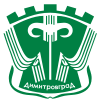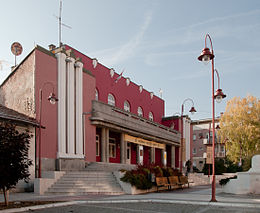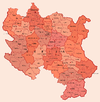- Dimitrovgrad, Serbia
-
Dimitrovgrad
Димитровград
Цариброд— Municipality and Town — View of Dimitrovgrad with the Church of the Mother of God built by the Bulgarian state in 1892. 
Coat of armsLocation of the municipality of Dimitrovgrad within Serbia Coordinates: 43°01′N 22°47′E / 43.017°N 22.783°E Country Serbia District Pirot Settlements 43 Government - Mayor Veselin Veličkov, DS Area[1] - Municipality 483 km2 (186.5 sq mi) Population (2011 census)[2] - Town 6,247 - Municipality 10,056 Time zone CET (UTC+1) - Summer (DST) CEST (UTC+2) Postal code 18320 Area code +381 10 Car plates PI Website www.dimitrovgrad.rs Dimitrovgrad (Serbian Cyrillic: Димитровград, Bulgarian: Цариброд, Tsaribrod) is a town and 483 km² large municipality located in the Pirot District of the Republic of Serbia. According to 2011 census, the municipality of Dimitrovgrad has a population of 10,056 people and the town 6,247.
Contents
Name
The official Serbian name is Dimitrovgrad (Димитровград), but the name Caribrod (Цариброд) is also used in Serbian. In Bulgarian, the name Tsaribrod (Цариброд) is preferred because there is another town called Dimitrovgrad on the Maritsa river in Bulgaria and Tsaribrod was used before the town became part of Serbia; it can sometimes be transliterated as Caribrod or Tzaribrod.
Dimitrovgrad was named after Georgi Dimitrov, a Bulgarian Communist leader.
There have been attempts to return the old name, Caribrod, but the last referendum, held on Sunday, June 13, 2004, was invalid due to a low turnout. Only 47.8% of the 9,811 voters on the electoral roll turned out to vote, while 50% was the required minimum. Of those who voted on the issue, 2,586 were in favour of keeping the name Dimitrovgrad, while 1,786 wanted the name Caribrod to be returned. [2]
Demographics
Year Population[3]
(Town)1948 2,944 1953 2,891 1961 3,665 1971 5,488 1981 7,055 1991 7,196 2002 6,968 According to the 1991 census, the absolute ethnic majority in the municipality were ethnic Bulgarians, while according to the 2002 census, the municipality was ethnically mixed, with relative Bulgarian ethnic majority.
According to the 2002 census data, the population of the Dimitrovgrad municipality was 11,748 people, and it was composed of:[3]
- Bulgarians = 5,836 (49.68%)
- Serbs = 3,005 (25.58%)
- Others.
Regardless of ethnic self-identification, most of the town's population speaks a South Slavic dialect usually called shopski which includes linguistic features of both Serbian (noun declension) and Bulgarian (postposed definite articles and lack of the infinitive verb form), as well as some entirely unique vocabulary.
History
Thracians inhabited the area in ancient times. The Celtic Scordisci invaded the territory in 279 BC.
The Roman road "Via Militaris" was built in the 1st century AD and went through the town. In May 2010, well-preserved remains of the road were excavated during the work on Corridor 10.[4]
An Ottoman military base operated in the west of Dimitrovgrad prior to the Balkan nations full independence.[5]
The Serbian and Bulgarian Prime ministers met at Tsaribrod in 1912 to discuss the disputed territories in Macedonia.[6]
The Kingdom of Yugoslavia gained parts of Bulgaria (known in Bulgaria as Western Outlands) which included Tsaribrod following the Treaty of Neuilly, signed on November 27, 1919. Between 1920 and 1941 the population of the region was denied any right to education or church services in Bulgarian and was officially regarded as Serbian by the Yugoslav authorities, including changed Bulgarian names to Serbian[citation needed]. Its interests were protected by the paramilitary organization Internal Western Outland Revolutionary Organisation known as Vrtop.
See also
References
- ^ "Municipalities of Serbia, 2006". Statistical Office of Serbia. http://webrzs.stat.gov.rs/axd/en/Zip/OG2006webE.zip. Retrieved 2010-11-28.
- ^ (in Serbian) Popis stanovništva, domaćinstava i Stanova 2002. Knjiga 1: Nacionalna ili etnička pripadnost po naseljima. Statistical Office of Serbia. 2003. ISBN 86-84443-00-09. May be downloaded from: [1]
- ^ a b c Књига 9, Становништво, упоредни преглед броја становника 1948, 1953, 1961, 1971, 1981, 1991, 2002, подаци по насељима, Републички завод за статистику, Београд, мај 2004, ISBN 86-84433-14-9
- ^ http://www.sci-tech-today.com/story.xhtml?story_id=13100D04HFJE
- ^ http://books.google.se/books?id=yqVNn1ZFKkYC
- ^ http://books.google.se/books?id=HaA18-u7mMMC
External links
- Official municipality web site
- The Bulgarian minority cultural community in Dimitrovgrad
- Report of the United Nations on the situation of the Bulgarian minority in Dimitrovgrad
- Caribrod's News Group
Categories:- Populated places in Pirot District
- Municipalities of Central Serbia
- Bulgaria–Serbia border crossings
Wikimedia Foundation. 2010.








